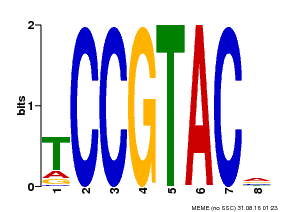- Cardon G, et al.
Molecular characterisation of the Arabidopsis SBP-box genes.
Gene, 1999. 237(1): p. 91-104
[PMID:10524240] - Riechmann JL, et al.
Arabidopsis transcription factors: genome-wide comparative analysis among eukaryotes.
Science, 2000. 290(5499): p. 2105-10
[PMID:11118137] - Seki M, et al.
Functional annotation of a full-length Arabidopsis cDNA collection.
Science, 2002. 296(5565): p. 141-5
[PMID:11910074] - Rhoades MW, et al.
Prediction of plant microRNA targets.
Cell, 2002. 110(4): p. 513-20
[PMID:12202040] - Folta KM,Pontin MA,Karlin-Neumann G,Bottini R,Spalding EP
Genomic and physiological studies of early cryptochrome 1 action demonstrate roles for auxin and gibberellin in the control of hypocotyl growth by blue light.
Plant J., 2003. 36(2): p. 203-14
[PMID:14535885] - Schmid M, et al.
Dissection of floral induction pathways using global expression analysis.
Development, 2003. 130(24): p. 6001-12
[PMID:14573523] - Yamada K, et al.
Empirical analysis of transcriptional activity in the Arabidopsis genome.
Science, 2003. 302(5646): p. 842-6
[PMID:14593172] - L
A new SBP-box gene BpSPL1 in silver birch (Betula pendula).
Physiol Plant, 2004. 120(3): p. 491-500
[PMID:15032847] - Kidner CA,Martienssen RA
The role of ARGONAUTE1 (AGO1) in meristem formation and identity.
Dev. Biol., 2005. 280(2): p. 504-17
[PMID:15882589] - Birkenbihl RP,Jach G,Saedler H,Huijser P
Functional dissection of the plant-specific SBP-domain: overlap of the DNA-binding and nuclear localization domains.
J. Mol. Biol., 2005. 352(3): p. 585-96
[PMID:16095614] - Wu G,Poethig RS
Temporal regulation of shoot development in Arabidopsis thaliana by miR156 and its target SPL3.
Development, 2006. 133(18): p. 3539-47
[PMID:16914499] - Gandikota M, et al.
The miRNA156/157 recognition element in the 3' UTR of the Arabidopsis SBP box gene SPL3 prevents early flowering by translational inhibition in seedlings.
Plant J., 2007. 49(4): p. 683-93
[PMID:17217458] - Yamaguchi A, et al.
The microRNA-regulated SBP-Box transcription factor SPL3 is a direct upstream activator of LEAFY, FRUITFULL, and APETALA1.
Dev. Cell, 2009. 17(2): p. 268-78
[PMID:19686687] - Sanchez SE,Cagnola JI,Crepy M,Yanovsky MJ,Casal JJ
Balancing forces in the photoperiodic control of flowering.
Photochem. Photobiol. Sci., 2011. 10(4): p. 451-60
[PMID:21125113] - Jung JH,Seo PJ,Kang SK,Park CM
miR172 signals are incorporated into the miR156 signaling pathway at the SPL3/4/5 genes in Arabidopsis developmental transitions.
Plant Mol. Biol., 2011. 76(1-2): p. 35-45
[PMID:21373962] - Lal S,Pacis LB,Smith HM
Regulation of the SQUAMOSA PROMOTER-BINDING PROTEIN-LIKE genes/microRNA156 module by the homeodomain proteins PENNYWISE and POUND-FOOLISH in Arabidopsis.
Mol Plant, 2011. 4(6): p. 1123-32
[PMID:21653282] - Jung JH,Ju Y,Seo PJ,Lee JH,Park CM
The SOC1-SPL module integrates photoperiod and gibberellic acid signals to control flowering time in Arabidopsis.
Plant J., 2012. 69(4): p. 577-88
[PMID:21988498] - Yang L,Wu G,Poethig RS
Mutations in the GW-repeat protein SUO reveal a developmental function for microRNA-mediated translational repression in Arabidopsis.
Proc. Natl. Acad. Sci. U.S.A., 2012. 109(1): p. 315-20
[PMID:22184231] - Kim JJ, et al.
The microRNA156-SQUAMOSA PROMOTER BINDING PROTEIN-LIKE3 module regulates ambient temperature-responsive flowering via FLOWERING LOCUS T in Arabidopsis.
Plant Physiol., 2012. 159(1): p. 461-78
[PMID:22427344] - Hwan Lee J,Joon Kim J,Ahn JH
Role of SEPALLATA3 (SEP3) as a downstream gene of miR156-SPL3-FT circuitry in ambient temperature-responsive flowering.
Plant Signal Behav, 2012. 7(9): p. 1151-4
[PMID:22899051] - Heidari B,Nemie-Feyissa D,Kangasjärvi S,Lillo C
Antagonistic regulation of flowering time through distinct regulatory subunits of protein phosphatase 2A.
PLoS ONE, 2013. 8(7): p. e67987
[PMID:23976921] - Jorgensen SA,Preston JC
Differential SPL gene expression patterns reveal candidate genes underlying flowering time and architectural differences in Mimulus and Arabidopsis.
Mol. Phylogenet. Evol., 2014. 73: p. 129-39
[PMID:24508602] - Le MH,Cao Y,Zhang XC,Stacey G
LIK1, a CERK1-interacting kinase, regulates plant immune responses in Arabidopsis.
PLoS ONE, 2014. 9(7): p. e102245
[PMID:25036661] - Jin J, et al.
An Arabidopsis Transcriptional Regulatory Map Reveals Distinct Functional and Evolutionary Features of Novel Transcription Factors.
Mol. Biol. Evol., 2015. 32(7): p. 1767-73
[PMID:25750178] - Yu N,Niu QW,Ng KH,Chua NH
The role of miR156/SPLs modules in Arabidopsis lateral root development.
Plant J., 2015. 83(4): p. 673-85
[PMID:26096676] - Lei KJ, et al.
Modulation of the Phosphate-Deficient Responses by MicroRNA156 and its Targeted SQUAMOSA PROMOTER BINDING PROTEIN-LIKE 3 in Arabidopsis.
Plant Cell Physiol., 2016. 57(1): p. 192-203
[PMID:26647245] - Xu M, et al.
Developmental Functions of miR156-Regulated SQUAMOSA PROMOTER BINDING PROTEIN-LIKE (SPL) Genes in Arabidopsis thaliana.
PLoS Genet., 2016. 12(8): p. e1006263
[PMID:27541584] - Jung JH,Lee HJ,Ryu JY,Park CM
SPL3/4/5 Integrate Developmental Aging and Photoperiodic Signals into the FT-FD Module in Arabidopsis Flowering.
Mol Plant, 2016. 9(12): p. 1647-1659
[PMID:27815142] - Duan HC, et al.
ALKBH10B Is an RNA N6-Methyladenosine Demethylase Affecting Arabidopsis Floral Transition.
Plant Cell, 2017. 29(12): p. 2995-3011
[PMID:29180595] - Negishi K,Endo M,Abe M,Araki T
SODIUM POTASSIUM ROOT DEFECTIVE1 regulates FLOWERING LOCUS T expression via the microRNA156-SQUAMOSA PROMOTER BINDING PROTEIN-LIKE3 module in response to potassium conditions.
Plant Cell Physiol., 2018. 59(2): p. 404-413
[PMID:29253219] - Cardon GH,Höhmann S,Nettesheim K,Saedler H,Huijser P
Functional analysis of the Arabidopsis thaliana SBP-box gene SPL3: a novel gene involved in the floral transition.
Plant J., 1997. 12(2): p. 367-77
[PMID:9301089]
|





